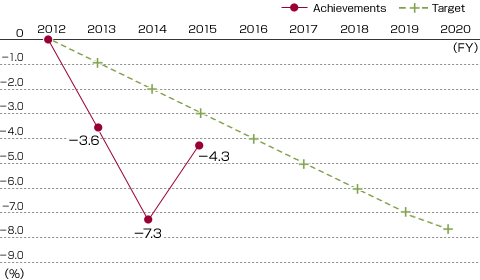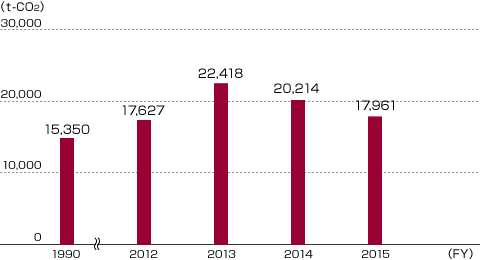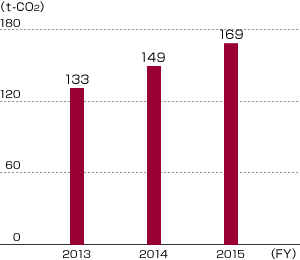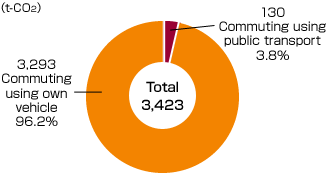 Global Warming Prevention
Global Warming Prevention

Basic Policy
The Advantest Group regard the prevention of global warming as an important corporate mission, and make efforts to reduce greenhouse gas emission by providing green products and reforming of our business processes. We are also promoting medium- to long-term energy-saving measures corresponding to the Act on the Rational Use of Energy (Energy Conservation Law) and related regulations.
Advantest’s Achievements in Relation to Carbon Dioxide Emissions in fiscal 2015
Advantest is working to simultaneously achieve both energy-savings and cost reduction through more efficient production and elimination of waste. In our buildings, we are optimizing air-conditioning and other systems and replacing superannuated equipment with more efficient models, as well as implementing appropriate lighting levels and switching to LED illumination.
Advantest’s total annual electric power consumption in fiscal 2015 was approximately 2,600 MWh lower than in fiscal 2014. The main factors behind this decrease were as follows: Mergers and closures of business bases led to an annual decrease of around 1,280 MWh; reductions in the amount of electric power used in production activities led to an annual decrease of around 960 MWh; reductions in the amount of overtime worked, efforts to make business processes more efficient, etc., led to an annual decrease of around 320 MWh. Shortening of the periods for which air conditioning equipment is in use, and the replacement of existing lighting with LED lights, etc., contributed an additional annual decrease of approximately 40 MWh. As a result, the rate of improvement in per-unit energy consumption* was approximately -4.3% (compared to fiscal 2012).
In the future, Advantest will continue its efforts to reduce carbon dioxide emissions by adopting a waste-elimination approach and aiming to achieve both energy-savings and cost reductions.
* Rate of improvement in per-unit energy consumption:Introducing energy saving equipment and promoting the efficient utilization of energy, and realizing an annual average improvement of 1% in per-unit energy consumption at Advantest business bases in Japan (Compared to the reference year fiscal2012, 5% or more reduction in fiscal2017, 7.73% or more by fiscal 2020)
Rate of improvement in per-unit energy consumption

Scope: 10 bases in Japan (including affiliates)
GHG emissions (Scope 1, 2)

Scope: 10 bases in Japan (including affiliates)
Carbon Dioxide Emissions Deriving from the Delivery of Products
When delivering its products, Advantest makes use of product packaging and transportation methods that take into account the needs of handling and shock-resistance. Total carbon dioxide emissions deriving from product delivery in fiscal 2015 came to 169 t-CO2. The increase in carbon dioxide emission volume was mainly attributable to changes in final destinations for delivery, with increased delivery distance. In the future, Advantest will continue to monitor the data relating to product delivery, and will calculate the related carbon dioxide emissions and strive for improvement in this area.
| Important measures implemented | Due to the fact that Advantest’s products are precision machinery that cannot be transported in ordinary cargo containers and cannot be transported together with other products, Advantest is implementing the following measures:
|
|---|
Changes in carbon dioxide emissions attributable to product delivery

The totals given include: Carbon dioxide emissions deriving from the delivery of products within Japan
Delivery to locations specified by customers (such as factories, airports and port facilities, etc.) using special trucks
Carbon Dioxide Emissions Deriving from Commuting
Of the approximately 2,500 Advantest employees (including employees of affiliate companies) in Japan, 85% commute to work using their own vehicles. In fiscal 2015, the total annual carbon dioxide emissions deriving from employees’ commuting was 3,423 t-CO2.
Advantest will continue to implement measures to discourage drivers from allowing the engine to idle unnecessarily while stopped, through the use of driving safety classes etc.
Breakdown of carbon dioxide emissions deriving from employee commuting

Activity volume: Employee expenditure on commuting (broken down by means of transport); distance commuted using employee’s own vehicle
Basic units: Derived from the “Emissions Unit Database (Ver. 2.1) for the Calculation of Greenhouse Gas Emissions etc. by Organizations Through the Supply Chain” compiled by the Ministry of the Environment (MOE) and the Ministry of Economy, Trade and Industry (METI).
Measuring Relating to the Use of “Green” Power at Overseas Business Locations
Purchasing “Green” Electric Power Generated Using Wind Power
Advantest America, Inc. (AAI) has made a serious commitment to the utilization of renewable energy. To reduce the impact that AAI’s use of electric power has on the environment, wind power generation is used to provide electric power equivalent to 100% of that used by AAI’s facilities.

Registration certificate
Installation of Large-Scale Photovoltaic Panels
Advantest Korea Co., Ltd. (ATK) is promoting a wide range of environmental activities.
At ATK’s Cheonan factory, photovoltaic panels have been installed on the roof, with an annual generating capacity of approximately 1,325 MWh; these solar panels contribute to a reduction in carbon dioxide emissions. ATK is also implementing various other measures, including careful sorting of waste and a “No Food Left on Plates Activity” aimed at reducing the amount of food waste generated by ATK’s employee cafeterias, by encouraging employees not to leave any leftovers food on their plates.
Photovoltaic panels


